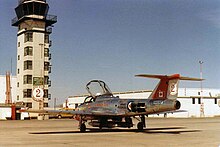Flight training development
Flight training Design and development
Design and development[edit]
The BAC 167 Strikemaster is essentially an armed version of the Jet Provost T Mk 5; the Strikemaster was modified with an uprated engine, wing hardpoints capable of carrying 4 500 pound Mk82 bombs, two machine guns under the intakes, uprated flap system with two jacks, larger airbrake jacks, new communication and navigation gear, different electrical system, canopy breakers on the ejection seats, and a revised fuel system including conformal fuel tanks on the wing tips.[2] First flown in 1967, the aircraft was marketed as a light attack or counter-insurgency aircraft, but most large-scale purchasers were air forces wanting an advanced trainer, although Ecuador, Oman and Yemen have used their aircraft in combat. A total of 146 were built.
Operational history[edit]
The Strikemaster was capable of operating from rough air strips, with dual ejection seats suitable even for low-altitude escape, and it was therefore widely used by third-world nations. Operations by the type were restricted by most military users after the Royal New Zealand Air Force found fatigue cracking in the wings of its aircraft. Many aircraft retired by Botswana, New Zealand, Saudi Arabia and Singapore have found their way into museums and private collections.
The Strikemaster was deployed by the Royal Air Force of Oman on several occasions during the Dhofar Rebellion, including a notable appearance providing Close Air Support during the Battle of Mirbat. Three Strikemasters were shot down over the course of the war, including one lost to an SA-7 missile.
The Ecuadorian Air Force deployed the Strikemaster during the brief 1995 Cenepa War, flying ground sorties against Peruvian positions. An Ecuadorian Strikemaster crashed during a training mission in the Northern Border area, near Colombia, on 25 March 2009. Both pilots ejected; one later died of injuries received during the rescue attempt.[3]
elementary jet flight training and other training to an advanced level. The prototype first flew on 13 January 1960.
One critical area of design was the positioning of the vertical stabilizer (fin). The CL-41 was intended to demonstrate spin recovery. If the fin is too far forward, a spin cannot be initiated, but if it is too far aft, recovery becomes impossible. Model tests were done to find the optimum position. The original Tutor wind-tunnel model had a cruciform tail, which was revised to the T-tail design by removing the portion above the horizontal stabilizer.[citation needed]
Operational history[edit]
 Canadair also developed an armament training and light attack variant, the CL-41G, with an uprated engine and underwing hard points to allow the carriage of external stores (up to 4,000 lb (1814 kg) of weapons) and drop tanks. In March 1966, the Royal Malaysian Air Force ordered twenty (serials M-22-01 to M22-11) examples of the CL-41G-5 Tebuan (which means Wasp in the Malay language) aircraft as counterinsurgency (COIN) aircraft. The Tebuan entered service in Malaysia in 1967, serving for over twenty years, before being phased out in June 1986 and replaced by the Aermacchi MB-339A.[citation needed]
Canadair also developed an armament training and light attack variant, the CL-41G, with an uprated engine and underwing hard points to allow the carriage of external stores (up to 4,000 lb (1814 kg) of weapons) and drop tanks. In March 1966, the Royal Malaysian Air Force ordered twenty (serials M-22-01 to M22-11) examples of the CL-41G-5 Tebuan (which means Wasp in the Malay language) aircraft as counterinsurgency (COIN) aircraft. The Tebuan entered service in Malaysia in 1967, serving for over twenty years, before being phased out in June 1986 and replaced by the Aermacchi MB-339A.[citation needed]
One other variant was developed, the CL-41R which was fitted with an F-104 Starfighter nose as a proposed electronic systems trainer for future RCAF CF-104 pilots. A single airframe (CF-LTX-X) was built but the R model never went into production.[citation needed]
Aerobatics[edit]
 In 1967, ten Tutors were modified for use as a formation aerobatic aircraft by the RCAF (and later the unified Canadian Forces) display team, the Golden Centennaires to celebrate Canada's centennial year. The display team was disbanded after the 1967 season. In 1971 a formation team was formed at 2CFFTS (Two Canadian Forces Flying Training School) at CFB Moose Jaw. In 1972 the name "Snowbirds" was chosen and in 1978 the team gained squadron status as 431 Air Demonstration Squadron, who continue to perform at air shows and special events including the annual flypast on Canada Day over the capital city, Ottawa.[citation needed]
In 1967, ten Tutors were modified for use as a formation aerobatic aircraft by the RCAF (and later the unified Canadian Forces) display team, the Golden Centennaires to celebrate Canada's centennial year. The display team was disbanded after the 1967 season. In 1971 a formation team was formed at 2CFFTS (Two Canadian Forces Flying Training School) at CFB Moose Jaw. In 1972 the name "Snowbirds" was chosen and in 1978 the team gained squadron status as 431 Air Demonstration Squadron, who continue to perform at air shows and special events including the annual flypast on Canada Day over the capital city, Ottawa.[citation needed]
Modifications for the Snowbirds include: a smoke generating system, a unique paint scheme for added crowd appeal, and a highly tuned engine to enhance engine response in low-level flying.[citation needed]












No comments